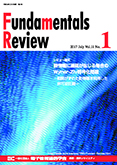Volume 11, Issue 1
Displaying 1-21 of 21 articles from this issue
- |<
- <
- 1
- >
- >|
Cover
-
2017 Volume 11 Issue 1 Pages 1_0
Published: July 01, 2017
Released on J-STAGE: July 01, 2017
Download PDF (285K)
Table of Contents
-
2017 Volume 11 Issue 1 Pages 1
Published: July 01, 2017
Released on J-STAGE: July 01, 2017
Download PDF (125K)
Preface
-
2017 Volume 11 Issue 1 Pages 2-3
Published: July 01, 2017
Released on J-STAGE: July 01, 2017
Download PDF (375K) -
2017 Volume 11 Issue 1 Pages 4-5
Published: July 01, 2017
Released on J-STAGE: July 01, 2017
Download PDF (428K)
Advanced Review Papers
-
2017 Volume 11 Issue 1 Pages 6-16
Published: July 01, 2017
Released on J-STAGE: July 01, 2017
Download PDF (11563K)
Review Papers
Proposed by ISEC
-
2017 Volume 11 Issue 1 Pages 17-27
Published: July 01, 2017
Released on J-STAGE: July 01, 2017
Download PDF (5036K)
Proposed by CAS
-
2017 Volume 11 Issue 1 Pages 28-39
Published: July 01, 2017
Released on J-STAGE: July 01, 2017
Download PDF (8897K)
Proposed by SIP
-
2017 Volume 11 Issue 1 Pages 40-53
Published: July 01, 2017
Released on J-STAGE: July 01, 2017
Download PDF (13034K)
Proposed by WBS
-
2017 Volume 11 Issue 1 Pages 54-62
Published: July 01, 2017
Released on J-STAGE: July 01, 2017
Download PDF (5015K)
Miscellaneous Articles
ESS News
-
2017 Volume 11 Issue 1 Pages 63-67
Published: July 01, 2017
Released on J-STAGE: July 01, 2017
Download PDF (1482K)
Let's go to IEICE Workshops!
-
2017 Volume 11 Issue 1 Pages 68
Published: July 01, 2017
Released on J-STAGE: July 01, 2017
Download PDF (316K) -
2017 Volume 11 Issue 1 Pages 69
Published: July 01, 2017
Released on J-STAGE: July 01, 2017
Download PDF (531K) -
2017 Volume 11 Issue 1 Pages 70
Published: July 01, 2017
Released on J-STAGE: July 01, 2017
Download PDF (212K) -
2017 Volume 11 Issue 1 Pages 70b-71
Published: July 01, 2017
Released on J-STAGE: July 01, 2017
Download PDF (266K) -
2017 Volume 11 Issue 1 Pages 71
Published: July 01, 2017
Released on J-STAGE: July 01, 2017
Download PDF (226K) -
2017 Volume 11 Issue 1 Pages 72
Published: July 01, 2017
Released on J-STAGE: July 01, 2017
Download PDF (126K)
Winners' Voice
-
2017 Volume 11 Issue 1 Pages 73-77
Published: July 01, 2017
Released on J-STAGE: July 01, 2017
Download PDF (1637K)
Tokyo City University (IEICE Society Conference Venue) Report
-
2017 Volume 11 Issue 1 Pages 78-79
Published: July 01, 2017
Released on J-STAGE: July 01, 2017
Download PDF (800K)
Call for Papers
-
2017 Volume 11 Issue 1 Pages 80
Published: July 01, 2017
Released on J-STAGE: July 01, 2017
Download PDF (412K)
Call for Participants
-
2017 Volume 11 Issue 1 Pages 81-84
Published: July 01, 2017
Released on J-STAGE: July 01, 2017
Download PDF (419K)
Committees & Editors Notes
-
2017 Volume 11 Issue 1 Pages 85-87
Published: July 01, 2017
Released on J-STAGE: July 01, 2017
Download PDF (356K)
- |<
- <
- 1
- >
- >|
